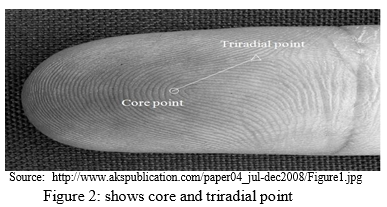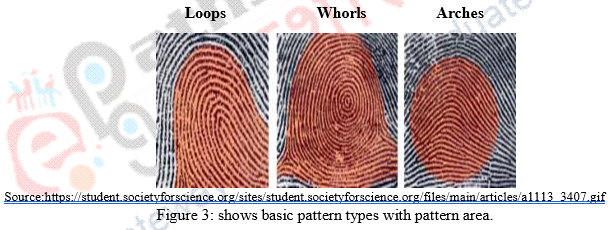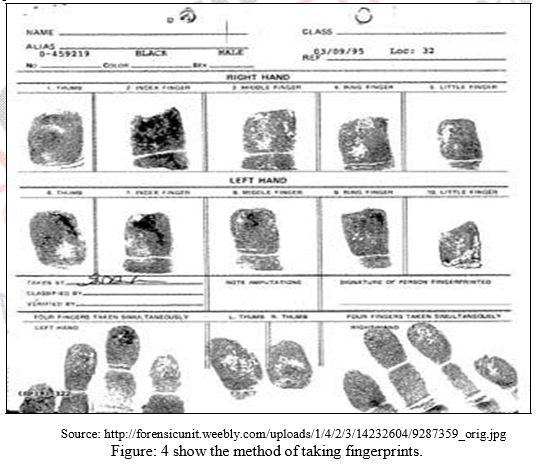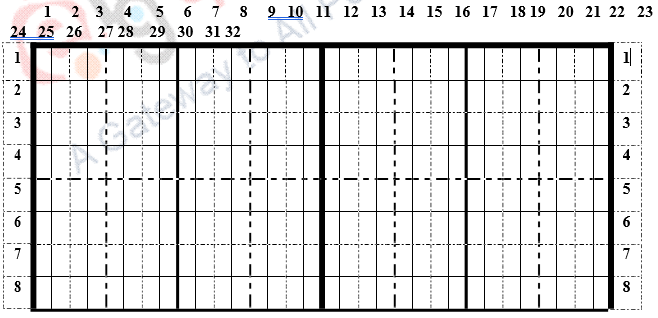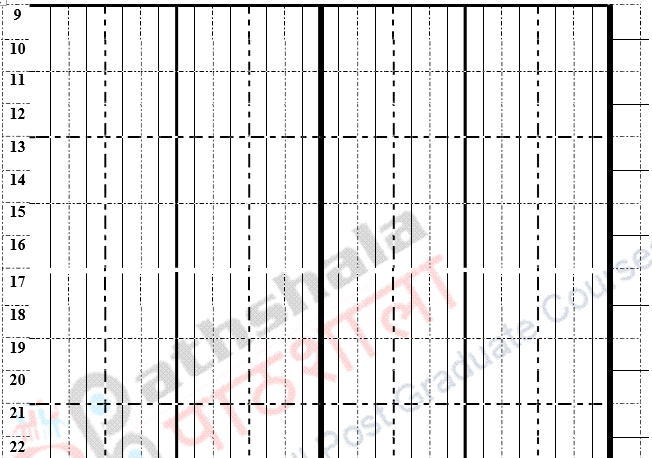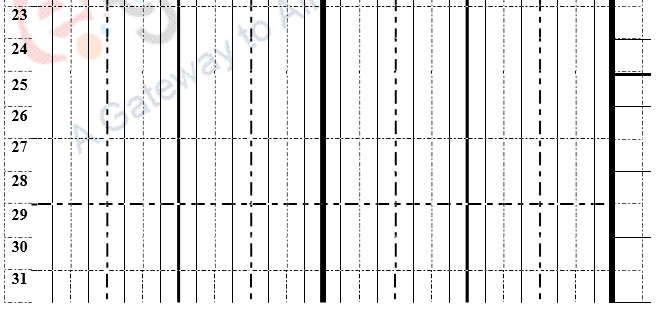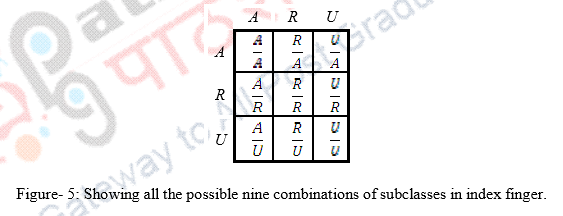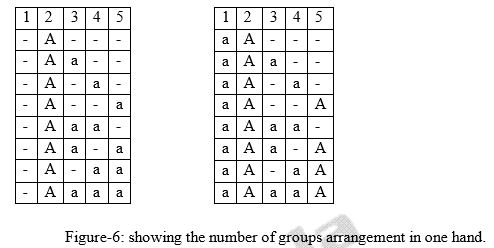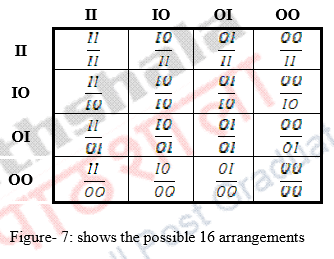16 Classification for Filing Fingerprints
1. Introduction:
The primary objective of classification of fingerprints is to devise the formula by which a given set of fingerprints can be traced and recorded. Each individual possess unique fingerprints and we have a large population. So, in order to match a fingerprint from crime scene to the recorded fingerprints in the bureau, a method for filing fingerprints is necessary to efficiently match in appropriate time. As it is really a time consuming process to match each and every recorded fingerprint, a proper method of classification of fingerprint for searching purpose is needed. Before classification of fingerprint, it is necessary to know about fingerprints.
Fingerprints can be defined as the prints or impression of the fingers on any material like paper, glass, or clothes. There are three fundamental principles of fingerprints: First, Fingerprints are individual characteristics and no two people can have exactly the same pattern of fingerprints even the monozygotic twins have different fingerprints. This is the first fundamental principle of fingerprints. Second, principle says that a fingerprint does not change throughout the lifetime of an individual and this is the reason behind its world wide application in identification of individuals. Third, fundamental principle again refines its application in identification by stating that fingerprints have ridge patterns which can be classified. Fingerprints are categorized on the basis of presence or absence of patterns such as whorls, loops and arches.
Fingerprint fixed points: These are the points by which a particular pattern can be identified. These are point of core and the triradial point. Point of core can be referred to as the landmark of ridge counting. Triradial point provides the landmark for ridge tracing and thus provides the outer border of pattern area.
Ridge patterns: There are three basic types of patterns in fingerprints – Arches, loops and Whorls. These basic patterns are again subdivided on the basis of complexity of the ridges. Thus Arches can be – Plain Arch or tented arch; Loops can be divided into Ulnar loop and radial loops; Whorls can be divided into plain whorl or composites which include central pocket, lateral pocket, twinned loop or accidentals.
2. Classification for filing finger prints:
Fingerprint classification system permits the retrieval of the paper records of concerned person from large databases of fingerprints in just a few minutes or it may help in the identification of matches between one to many search. Fingerprint classification is thus partitioning of large domain search into small subsets based on the type of query. It is widely used in criminal investigation sectors. Classification of fingerprints is done by assigning numerical values like alphabetical order is followed in dictionary to arrange words for the ease of search. The well known method of classification is known as ‘Henry system of classification’ which is universal in its use, named after its originator Sir Edward Richard Henry.
3. Henry system of classification
3.1 Primary classification:
Primary classification is derived taking into account the fact that arches occur 5 percent, loops 60 percent and whorls and composites being 35 percent of the impressions, therefore, in primary classification arches are included under loops and composites under whorls. Thus, a finger can possess either a loop or a whorl in primary classification.
3.1.1 Method:
The technique involved in taking fingerprints for classification purpose is as follows: In a slip, the rolled impression of the fingers of right hand is recorded in line in the order of thumb, index, middle, ring and little finger. Immediately below them, impressions of the fingers of left hand in the same order are recorded. Then at the bottom of the slip, plain impressions of index, middle and ring fingers of both hands are also recorded. For correct classification, it is essential that the fingers should be printed in correct sequence.
3.1.2 Symbols:
Before classification, the symbols for the patterns are marked below the patterns in the fingerprint slip and each pattern is assigned a numerical value. Thus Henry system of classification is divided into two classes: Those which have numerical values, and those which do not have numerical values.
Thus patterns having numerical values are whorls and composites whereas arches and loops have no numerical values.
3.1.3 Numerical values:
As the impressions are read off in pairs, numerical values are assigned by pairing of fingers. Thus five pairs are formed as right thumb and right index; right middle and right ring; right little finger and left thumb; left index and left middle; left ring and left little finger.
The arrangement possible in first pair are: right thumb a whorl, right index a loop; right thumb a loop, right index a whorl; both right thumb and right index have loop; both have whorl. Possible arrangements of the first pair with symbols are set out – the numerator letter refers to the first of the pair and the denominator letter refer to the second of the pair.
The same number of combination for second pair, i.e. 4 and when each of these compared with the combination of first pair then the total combination of the two pair becomes 16 (4 X 4). Likewise the third pair has 4 arrangements when compared with preceding two pairs, number of combination becomes 64, compared with fourth pair, combination raised to 256, and with the fifth pair, it becomes 1024. The number 1024 is the square of 32 thus a cabinet containing 32 sets of 32 holes arranged horizontally would provide locations for all combinations of loops and whorls taken in pair. Now, a whorl will be assigned a numerical value of 16 if occurs in the first pair; in the second pair, it assigned a value 8; in the third 4; in the fourth 2 and in the fifth 1. Loops do not possess any numerical value and therefore denoted as 0.
3.1.4 Classification:
Classification involves adding the numerical values separately of all the patterns present in numerator and denominator. Then a unit value is added to both the numerator and denominator. This is done to record the file of a person who has loop patterns in all the ten fingers.
Consider a pattern
3.2 Secondary classification:
The system can be further modified in case of large accumulations to make the filing and search easier as well as quicker by introducing secondary classification. Only the fingerprints of index finger are considered in secondary classification. Numerator denoting the symbol of right index finger whereas denominator, the symbol of left index finger. Thus the index finger of each hand is taken as fulcrum and capital letter is used to denote its pattern symbol. Symbol of the thumb in small letter is placed to the left of the fulcrum and symbol of the remaining fingers in small letter to the right of the fulcrum. In secondary classification, infrequently occurred patterns are utilized such as arches, tented arches and radial loops. Formula indicates that the slip containing the impression will be found under classification number , and it will be included in the collection specialized by having a tented arch in right thumb, an arch in the right index and a radial loop in one of the remaining fingers of the right hand while in the left hand there is a arch in left thumb; radial loops in both left index and one of the remaining finger.
3.3 Sub-classification or sub- secondary :
3.3.1 By Arches and Loops
In primary classification, we have distinguished between loops and whorls and loops arches, tented arches, radial and ulnar loops. So now we are about to distinguish them into subclasses and groups.
In index finger arches, radial and ulnar loop can occur in possible nine combinations for the formulation of nine subclasses as depicted
The letters arranged horizontally refer to the right, those vertically to the left index finger. Thus under subclass will found the slips with an arch in both index finger, under ,those with an radial loop in right and arch in the left index finger.
In subclass , Arches may occur in 1(thumb), 2(index), 3(middle), 4(ring), or 5(little) fingers in right as well as in left hand. The possible arrangements of groups are 16 as depicted below for one hand. So, the total number of groups created by utilizing them will be 16 X 16 = 256.
Likewise, in subclass ; in subclass ; in subclass ; 256 such groups can be made. However, in practice a smaller number is employed which is formed by deciding whether there are one, two or three Arches to the right of the index finger or fulcrum. These groups are denoted as depicted in figure- 4 as A; aA; Aa; aAa; A2a; aA2a; A3a; aA3a; they are arranged amongst themselves in this sequence. So, the possible arrangements are reduced to 8 instead of 16 and hence, 64 possible groups instead of 256 when considering both the hands.
- When Tented arches are present in place of arches then those slips are arranged below the slips containing the same number and position of Arches. Thus aA2t would be arranged below aA2a group; At below Aa group.
- When radial loops are present they are arranged immediately below the groups containing the same number of Arches and Tented Arches. Thus aA2r would be arranged below aA2t which is lying below aA2a.
3.2.2 By Ridge Counting
Ridge counting is done again for sub classification which further narrows down the domain of filing. In this, ridges in the impression of ulnar loops are counted. Considering the index finger, if ridge counting is 9 or less than 9 then the sub-classification symbol shall be I otherwise symbol will be O. In the case of middle and ring finger, if the ridge counting is upto 10 the sub-classification mark shall be I and if more than 10 then it will be symbolized as O. Taking both index and middle finger of both hands the number of possible arrangements are as follow:
The horizontally placed letters denotes the right index and middle whereas those placed vertically denotes the left index and middle finger. The advantage of this classification is that in most of the instances it is possible to decide at a glance that the impression falls within the I limit or the O limit as 17 ridge counts can be easily distinguished from 7 but greater accuracy is needed when the counts approach the limit between I and O. Now, the slips of these 16 groups are arranged amongst themselves according to the ridge counts in the right little finger. This further divides groups into subgroups. This particular classification is an extension of Henry’s classification and sometimes referred to as Final classification. If the right little is a whorl then the left little is used for classification. Now, if loops are absent in both the little finger, then the classification bears no final. This causes much saving of time in sub-classification and render search comparatively easy and rapid. The formula for one of these slips will be![]()
3.2.1 By Ridge Tracing
Sub- classification by ridge tracing is needed when all the slips of impressions are Whorls including Composites. A whorl may be either a inner whorl, outer whorl or meeting whorl. Thus sub- classification proceeds by first making division between them.
- Taking the index and middle finger of the right hand, index may be I or O or M and the middle finger may also be I or M or O. So the possible combination of the two fingers taken together will be (3 X 3 = 9).
- When similar arrangements of these two fingers of the left and right hand taken together, the total number of combination rises to 81 i.e. (9 X 9). Each of these becomes a separate identifiable group.
An example denoting the formula of such a slip is 32/32 MO/IM, where number 32/32 denoting the primary classification and MO/IM, the letters denotes sub-classification. The above formula can also be written as 32/32 (6/2) to further simplify where the figures in brackets denotes the groups formed under sub-classification. These groups are systematically arranged among themselves according to the numbers in bracket like (1/1), (2/1), (3/1), (4-9/1), and then (1/2), (2/2), (3/2), (4/2), (5-9/2), and so on.
The principle of ridge tracing is applicable to accumulations under 27/28, 31/28, 32/28, 28/32, 31/32, 32/32 primary classification. The advantage of sub-classification by ridge tracing is that central pockets, lateral pockets, twinned loops and accidentals can be distinguished into I, M or O at a glance. Careful tracing is needed when whorl has symmetrically disposed deltas.
4. Extension of Henry’s classification:
Extension was made and Henry’s classification was modified by including Major and key classification.
Major classification: This classification considers the patterns in thumb. If a loop is present then the ridge counting is performed in the usual manner whereas if a whorl is present, ridge tracing is done. Right hand thumb pattern is denoted in numerator and left hand thumb in denominator.
Key classification: It is the classification based on ridge count of first loop patterns excluding the little finger.
5. Sub-classification of mixed type:
When different types of patterns are present in the index and middle finger of the same hand i.e. a loop in index and a whorl in middle then the classification is referred as mixed type. In such cases only the index is deal with its ridge counting (for loops) or ridge tracing (for whorls). In the mixed sub- classification numerator denotes the counting or tracing of only the index finger and the denominator shows the combined result of both the fingers, if possess the same pattern. This applies to both the hands.
9/9 (I/( II)) ; 9/( 10) (O/( IO)) ; 9/( 26) (I/OI); 13/( 26) (O/( OI))
- In the above cases right index is a loop and right middle is a whorl and both left index and middle is loops. So, the numerators only denotes the ridge counting in right index while denominator shows the combined result of ridge counting of both index and middle finger.
28/2 (M/( I)) ; 31/( 18) (M/( O)) ; 31/( 22) (I/O); 32/( 22) (O/( I))
- In these cases right index is a whorl, the right middle is loop and the left index is loop, left middle is whorl. So the numerator denotes the ridge tracing of right index finger only and the denominator the ridge counting of left index only.
6. Classification of the missing or deformed fingers:
When a digit is missing or deformed, the space assigned to it in the slip remains blank. If one digit is missing then the classification is made on the basis of corresponding finger of the other hand. If the same finger of both the hands are missing then the absent ones are both considered as whorls and classification was made accordingly. The absence of two or more fingers is classified on the basis of the same rule. We assume that both the middle fingers of a person are missing and the marking of the remaining fingers are as follow:
W/L; /W;L/L;W/ ; W/L
In such case, the officer will first assume right middle as W and left as L ;then right as L and left as W ; then both right and left has W; and then both right and left as L.
The slip must be among the accumulations contained under the above four classification number. Now if three fingers are missing, search would have to be made under eight primary classification number, with four missing fingers 16 primary classification numbers has to be searched. Thus filing was done accordingly.
- When a person has more than ten fingers then the extra or additional fingers are printed on the other side of the slip with a notation made referring that there is an extra finger back side. Usually the thumb and the four fingers next to thumb of a person are considered in the front side of the slip who has any additional fingers.
- When a person has two or more fingers webbed together making it impossible to roll the fingers inside. In such cases fingers should be rolled as completely as possible and the notation was made denoting that they are joined.
7. Method of search in bureau:
According to the Henry system of classification the method of searching a slip containing impressions is as follows:
Step – 1: Finger impression of an individual was recorded and after classification by an officer, full formula was devised for example![]()
Step – 2: searcher will first verify the correctness of the formula then look for primary classification number which is in the above example and locate the pigeon hole in the cabinet.
Step – 3: searcher will then look for sub-classification. In the above example subclass ulnar loops are present in index finger of both hands.
Step – 4: now, searcher will look for sub sub-class or groups. In the above example will be located as a group within the file .
Step – 5: right little finger counts create error many a times. To eliminate this the searcher decides to search through the subgroups of ( ) which have 7 to 12 counts in the right little finger. Then he picks a file but concentrates attention towards the salient features of the slip and compares the ridge characteristics of one or two impressions of the slip with the corresponding impression of the slip in the record if tall exactly tally he would consider the search as successful and will remark about the search slip as “traced” whereas if it is fail to match then the search is said to be “untraced”.
Summary:
The method of classification for filing fingerprints devised by Mr. Henry is universally known as Henry system of classification. The primary classification divides all the different kinds of impression into two classes only, Loops and Whorls which can be recognized at a glance. By taking the possible combination of these two classes, as exhibited in the ten different fingers taken in pairs 1024 classes was devised and each class is allotted a separate pigeon hole in the cabinet thus generating primary classification number. To make the filing easier and quicker, secondary classification, sub- classification by arches & radial loops, by ridge counting, by ridge tracing was generated and the formula was devised. A practiced person can search among the largest of the accumulation say 30,000 slips within five to six minutes as he marked in his mind the salient features of the slip he is looking for, and thus can search for it as rapidly as his hand is able to turn over the record or filed slips.
| you can view video on Classifications for filing the finger prints |


